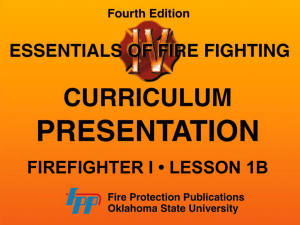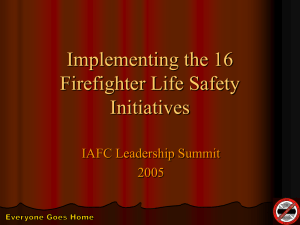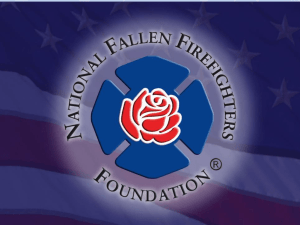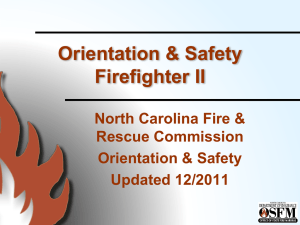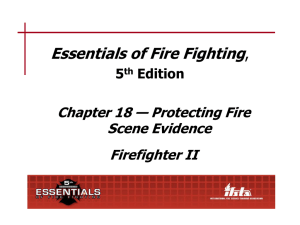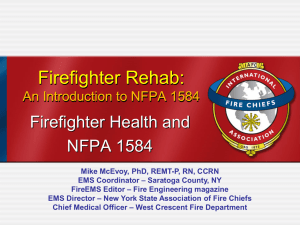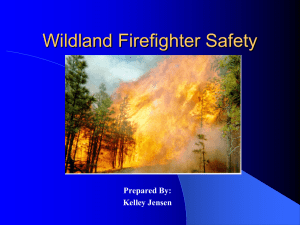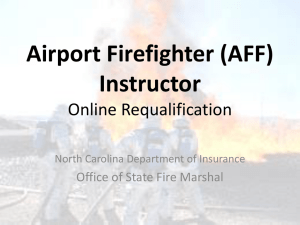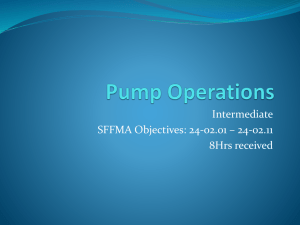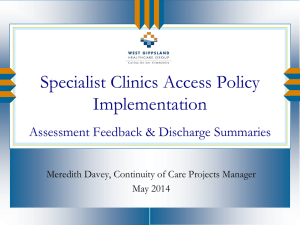Slides - RARE Campaign
advertisement
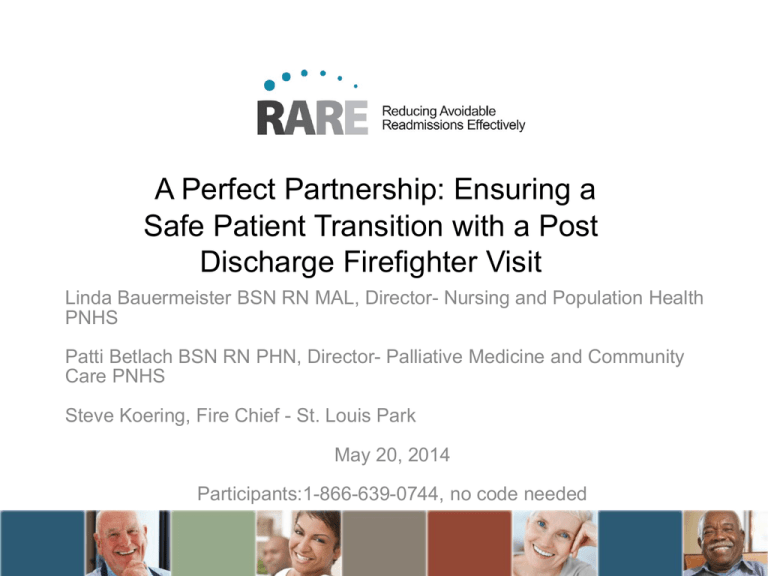
A Perfect Partnership: Ensuring a Safe Patient Transition with a Post Discharge Firefighter Visit Linda Bauermeister BSN RN MAL, Director- Nursing and Population Health PNHS Patti Betlach BSN RN PHN, Director- Palliative Medicine and Community Care PNHS Steve Koering, Fire Chief - St. Louis Park May 20, 2014 Participants:1-866-639-0744, no code needed A Perfect Partnership: Ensuring a Safe Patient Transition with a Post Discharge Firefighter Visit Linda Bauermeister BSN RN MAL Director- Nursing and Population Health PNHS Patti Betlach BSN RN PHN Director- Palliative Medicine and Community Care PNHS Steve Koering Fire Chief - St. Louis Park May 20, 2014 Objectives At the conclusion of this webinar, participants will be able to: 1. Learn how Park Nicollet Health Services partnered with the St. Louis Park Fire Department to address care transitions 2. List the components of the firefighter visit 3. Describe how the firefighter visit addresses the triple aim of a. Improving Population Health b. Improving the Experience of Care c. Improving the Affordability of Care How our story began • Park Nicollet has worked on patient transitions/readmissions since 2011 – RARE participant – Pioneer ACO • Many changes have been made to the way we deliver care including – Risk stratification – Standardized care coordination/transitions/ handoffs – Post DC phone calls – Improved After Visit Summaries Average of 49 patients go home with no services or with Home Care from Methodist Hospital / day Fire Department approached PN • 70% of calls for SLP Fire Department are EMS calls (about 10/day) – Many of these calls are from our patients who have been discharged • Opportunity to impact the pre-911 timeframe – Proactive intervention vs. reactive based on 911 call (resulting in fire, police, ambulance response) – Reinforce discharge messages in the patient’s home setting • Park Nicollet said YES! Let’s partner! Lean Methodology used to Create Program • PN has used Lean Methodology since 2003 – Structured approach and tools used – Dedication to reserving resources over defined period of time with a defined scope and targets • Prep - 3 meetings • Kaizen Event - 4 days (day 3 we tested visits) • Large multidisciplinary team including 4 patient partners and 7 Fire Departments from surrounding communities Theme To construct a process, tools, and measurement plan to pilot post hospital discharge visits by firefighters in April 2014 that addresses all elements of the triple aim. Targets 1. A Future state process flow including the new Post DC Hospital Visit 2. Detailed process flow of the Post DC Hospital Visit. 3. Identified key components of the visit. 4. Identified new structures and plans - i.e. dispatch function at Methodist 5. Creation of Tools needed to complete visit 6. Measurement plan including success measures and surveys 7. Training plan for pilot. 8. Completed visits on March 19 with results/suggestions for improvement 9. Pilot specifics - length of pilot, pilot review plan, next steps plan Items included in prep meetings • Sharing of information – Background on our transitions work – Readmission information – ACO information – Firefighter training • Addressing misconceptions • Identified who should be part of the team • Finalized scope and targets What we did over the 4 day event • We created what we needed to test 3 Post DC patient visits – Overall process and 4 sub processes – Visit components – Tools • We tested 3 visits and documented our learning/issues • We planned for the pilot including – Measures – Training Processes • Future state Patient Discharge flow process that includes the firefighter visit • Four sub processes- two owned by Methodist Hospital and two owned by Fire Department – – – – Patient ID and consent process Dispatch process Fire Department receipt of information process Fire Department scheduling/pre-visit/visit process Main components of the firefighter visit • Review of the following: – Meds - does the patient know what medications he/she should be taking? – Red flags - does the patient know the signs and symptoms to be aware of? • Does the patients know who to call and when? – Is there a follow up appointment scheduled? • PEAT - Physical environment assessment • Connect patient with any necessary resources Created the tools necessary to support the process • • • • • Flyer Opt in consent form Firefighter visit documentation tool Patient Survey Many other supporting items including – Fax sheets – Scripting – Resource sheets Flyer Opt in consent form Firefighter visit documentation tool Patient satisfaction tool We tested three visits Rodger reviewing the patient’s information in preparation for his call to the patient to schedule the visit Visit learning's • Each visit was different – One focused less on the discharge content and more on home safety – One involved medication clarification – One was directed around marketing the program and addressing a condition question (bruise on ankle) • Average cycle time of visit - 17 minutes • Patient feedback was positive - patient quote: “all of the info upon hospital discharge can be very overwhelming and it helps to clarify things in the comfort of your own home.” We identified issues- PN side • We have issues with the AVS- – it’s hard to find the primary provider – The medication section is confusing • Meds listed multiple times – A couple of AVS’ included the copy of “My Medications” list that would be good for the refrigerator door - we found out this is not an accurate list – The appointment section does not list reason for appointment. For example, “stress test” • We need standard work for faxing the patient info to Fire Department along with standard fax cover letter • We need Ziploc bags for meds not being taken We identified issues- Fire Department side • We need to work with Dispatch – Additional codes are needed for out of area • We need additional work on faxing process – Tag line on fax – Need cover letter for faxes to both the fire department and PN HIM • Would like to try folders and binder to hold the documents • Need to review the record retention requirements for SLP • We need a new solution to cover our feet when entering the home. Booties don’t work We identified issues - Fire Department side • We need job aides for – where to get extinguishers charged, drop down ladders – Difference between ionizing and non-ionizing smoke alarms – Fire pits/recreational fires • We need to inform of height requirement or provide 2 step ladder to check smoke detectors • We need criteria for a same day visit and discuss at huddles at hospital – i.e. lives alone – No person on arrival when patient gets home • Need list of pamphlets/other info needed - is there something on the PN website we could use? We identified issues- both sides • Can patients who need INR’s have lab appointment so it shows up on AVS? • We need scripting for staff/hospitalists to market this and make sure if the patient says “yes” that the patient will be home • We need a process for Head’s up email • We need a plan so that if firefighter is in another city they can get a lock box key for apartments • Can we find out if there a highlighter color that is best to use for elderly patients? We planned for the pilot • We will start the pilot on May 12, 2014 and include the SLP, Minneapolis, and Minnetonka fire departments • Until then, we will do test visits every week to work out the bugs and complete other tasks so that everything is done • A project plan has been created that includes training, communication and other pilot specifics. Triple Aim Impact of the Firefighter Visit Health •Patients have what they need to care for themselves at home and understand what to do if something changes Experience •Safe and success transition to home •Consistent and reinforced messages from PN team and firefighter colleagues Affordability •Decrease readmissions •Appropriate use of healthcare resources and decrease unnecessary 911 calls Re-cap of visits from 3/17-5/1/14 n=13 Our patient demographic data • Gender – Male - 4 – Female - 9 • Average age- 76 (range 25-94) • High risk- 2 documented (form updated) Visit info - n=13 • Ave # of times called to schedule visit- 1.6 • Average cycle time of visit - 22 minutes • Appointment times - 9:30 AM to 1:30 PM Visit info - outcomes of visit Patient Feedback- n=6 • I felt Methodist Hospital staff informed me about the firefighter visit in a way that I could understand - 100% strongly agree • The firefighter arrived within the arranged time frame - 100% strongly agree • The firefighter visit gave me confidence in managing my medications – – – – 33% strongly agree 50% agree 17% disagree 0% strongly disagree Patient Feedback - n=6 • Please rank the following four aspects of your firefighter visit according to what was most helpful to you - average ranking below – – – – Understanding medications - 3.2 Who to call with questions - 1.8 Understanding your follow-up appointments - 2 Home Safety Survey - 3 – – – – 71% strongly agree 29% agree 0% disagree 0% strongly disagree • I would recommend a firefighter visit to my family and friends Patient Feedback - n=6 • Comments – The firefighters could have been a little “warmer” in their communication. They seemed more “businessy.” – Great Program! – Especially for those patients not receiving a home care visit/follow-up, I feel this program could be very beneficial. All the info upon hospital discharge can be very overwhelming and it helps to clarify things in the comfort of your own home. – I think they did a good job! – Fantastic job - well worth it Areas still requiring work Getting patients to consent Future State- Patient Discharge Flow ID patients and Opt in process? What to document and how to transfer info to PN Pre-visit planning Patient hospitalized at Methodist Hospital Discharge planning completed and reviewed with patient including Firefighter visit Patient discharged to home. Firefighter visit scheduled. Information handoff to home care or clinic. Scheduling process with SLP FD Other items: 1. Plan Pilot 2. Billing and Accounting 3. Fire Department- redistribution of workload during peak periods. Scheduling considerations if major event 4. Testing the visits during KE 5. Communication 6. Education/Training 7. Data/Reporting 8. Address political issues 9. Visit standards for statewide use 10. Credentialing 11. What vehicle to show up in. 12. Marketing needs Firefighter visits with patient and documentation completed Patient given survey form to complete and send back to PN. Escalation process to additional resources Incomplete Visitspatient cancellations DC phone call to patient 24-72 hours post DC Home Care visit done or Patient goes to clinic for Hospital DC Visit Questions? Upcoming RARE Events…. RARE Action Learning Day and Reception June 17, 2014 (8:30 a.m. – 3:30 p.m.) Crown Plaza Hotel - Plymouth, MN Registration now open! Thank You… This is the final webinar for the RARE Campaign! To view past webinars visit, www.rarereadmissions.org
